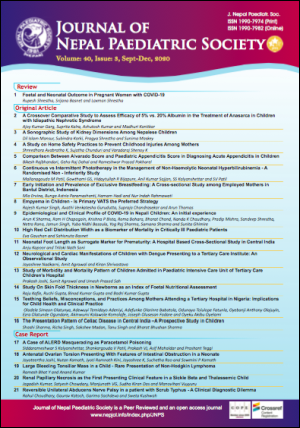The Presentation Pattern of Celiac Disease in Central India –A Prospective Study in Children
DOI:
https://doi.org/10.3126/jnps.v40i3.29509Keywords:
Biopsy, Celiac disease, Diarrhoea, Serum tissue transglutaminase antibodiesAbstract
Introduction: Celiac disease is a common immune-mediated enteropathy characterised by villous atrophy. It has clinical phenotypes of classic, non-gastrointestinal and silent/subclinical or potential depending on the clinical phenotype. We intended to assess the clinical features and laboratory findings of patients with celiac disease and compare the classical celiac disease with non-gastrointestinal celiac disease.
Methods: This is a two-year cross-sectional study conducted at our institute. Children from one year to 18 years diagnosed as celiac disease based on the revised ESPGHAN criteria were enrolled. They were categorised into classical celiac disease and non-gastrointestinal celiac disease (atypical) and their clinical features and laboratory findings were documented.
Results: Forty patients had confirmed celiac disease. The mean age of the subjects was 6.84 ± 4.41 years, with male: female ratio of 1.85. The commonest presentations were failure to thrive (75%), anaemia (70%), associated rickets (67.5%) and 32% diarrhoea. Patients with classical features were identified at an earlier age than those with non-gastrointestinal celiac disease. Marsh grade 3a and above were more commonly seen in classical celiac disease. The most common symptom among the classical group was abdominal distension. Among the non-gastrointestinal group, the most common symptom was anaemia. Vitamin D deficiency was almost equally present in both groups.
Conclusions: Non-gastrointestinal celiac disease is not uncommon among our population. Patients with clinical features of recurrent abdominal pain, vomiting, failure to thrive, or merely short stature and refractory anaemia should be worked up for celiac disease.
Downloads
Downloads
Published
How to Cite
Issue
Section
License
Authors who publish with this journal agree to the following terms:
Authors retain copyright and grant the journal right of first publication with the work simultaneously licensed under a Creative Commons Attribution License that allows others to share the work with an acknowledgement of the work's authorship and initial publication in this journal.
Authors are able to enter into separate, additional contractual arrangements for the non-exclusive distribution of the journal's published version of the work (e.g., post it to an institutional repository or publish it in a book), with an acknowledgement of its initial publication in this journal.
Authors are permitted and encouraged to post their work online (e.g., in institutional repositories or on their website) prior to and during the submission process, as it can lead to productive exchanges, as well as earlier and greater citation of published work (See The Effect of Open Access).



